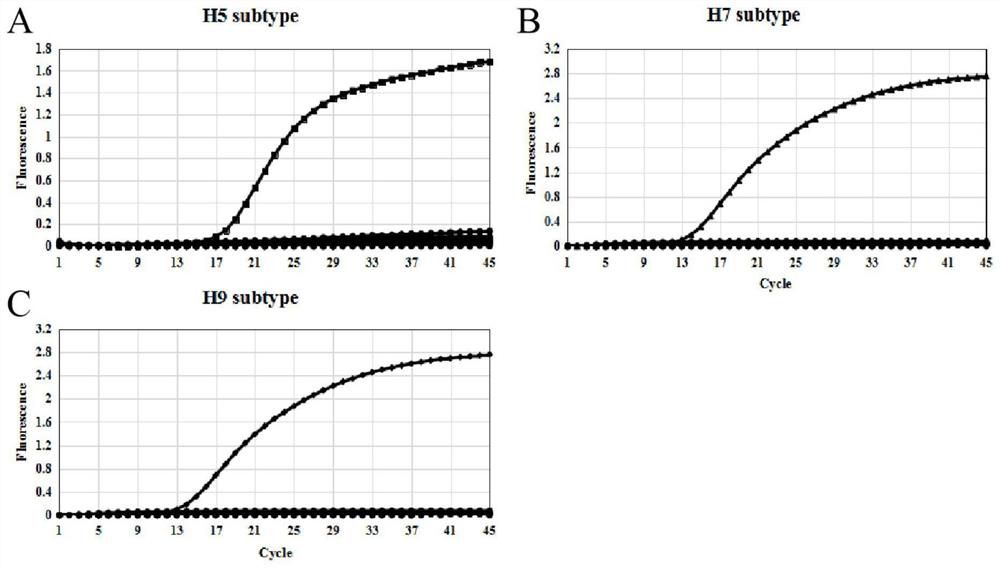Avian influenza virus H5, H7 and H9 subtype triple fluorescent quantitative RT-PCR detection kit and application thereof
The technology of a bird flu virus and detection kit is applied in the determination/testing of microorganisms, recombinant DNA technology, DNA/RNA fragments, etc., which can solve the problems of achieving sensitivity, achieve high sensitivity, good application potential and application value, low cost effect
- Summary
- Abstract
- Description
- Claims
- Application Information
AI Technical Summary
Problems solved by technology
Method used
Image
Examples
Embodiment 1
[0061] Design of Primers and Probes for Avian Influenza H5, H7, H9 Subtypes
[0062] This example refers to the hemagglutinin-related gene sequences of the H5, H7 and H9 subtypes of avian influenza virus published in the GenBank database, and uses the DNAMAN software to conduct a comparative analysis of gene homology to determine its nucleic acid conserved sequence region as a specific target fragment. Using Primer Express5.0 software, design specific primers and fluorescent probes for their specific target fragments. Experimental comparison proves that the preferred specific primers and fluorescent probes have a significant positive effect on improving the specificity of the reaction.
[0063] In the present invention, the specific probe of H5 subtype avian influenza virus HA gene carries Cy5 fluorescent reporter group and BHQ2 fluorescence quenching group respectively at its 5' end and 3' end; the specificity of H7 subtype avian influenza virus HA gene The sex probe carrie...
Embodiment 2
[0077] Optimization of reaction system and program for triple fluorescence quantitative RT-PCR
[0078] The present invention optimizes the amount of each probe, the concentration of each primer and the reaction parameters (annealing temperature) in the reaction program of the triple fluorescence quantitative RT-PCR reaction system.
[0079] In this example, it is preferable to use the response surface optimization design method to systematically design and analyze the reaction system and reaction program, and construct the corresponding response surface to obtain the optimal area. In this example, MODDE 12.1 (Umetrics, Sweden) software was used to optimize the central composite surface design as the response surface model in the central composite design, and the steepest descent method was used to find the optimal area, and a total of 17 optimization experiments were designed (as shown in Table 3 ).
[0080] Table 3 Triple fluorescence quantitative RT-PCR system optimization...
Embodiment 3
[0090] Drawing of standard curve
[0091] Using 10-fold serial serial dilutions of H5, H7 and H9 standard strain genomic RNAs as templates, according to the optimized reaction system and program, perform triple fluorescent quantitative RT-PCR amplification, and set up 3 for each reaction Repeat, set positive and negative controls at the same time, respectively use the logarithm of the initial nucleic acid copy number of the standard RNA of H5, H7 and H9 strains as the X-axis, and the Ct value as the Y-axis to draw a standard curve, and quantify the unknown samples through the standard curve. The amplification efficiency of the reaction and the slope and correlation coefficient of the standard curve were obtained. The result is as figure 1 Shown (wherein A is the H5 amplification curve; B is the H5 standard curve; C is the H7 amplification curve; D is the H7 standard curve; E is the H9 amplification curve; F is the H9 standard curve),
[0092] The H5 standard curve equation o...
PUM
 Login to View More
Login to View More Abstract
Description
Claims
Application Information
 Login to View More
Login to View More - R&D
- Intellectual Property
- Life Sciences
- Materials
- Tech Scout
- Unparalleled Data Quality
- Higher Quality Content
- 60% Fewer Hallucinations
Browse by: Latest US Patents, China's latest patents, Technical Efficacy Thesaurus, Application Domain, Technology Topic, Popular Technical Reports.
© 2025 PatSnap. All rights reserved.Legal|Privacy policy|Modern Slavery Act Transparency Statement|Sitemap|About US| Contact US: help@patsnap.com



